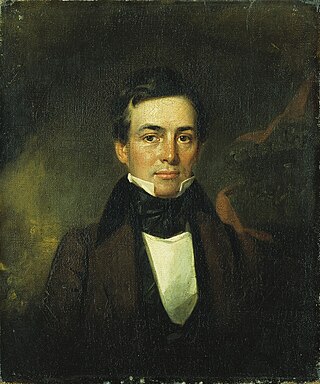The Anti-Masonic Party was the earliest third party in the United States. Formally a single-issue party, it strongly opposed Freemasonry in the United States. It was active from the late 1820s, especially in the Northeast, and later attempted to become a major party by expanding its platform to take positions on other issues. It declined quickly after 1832 as most members joined the new Whig Party; it disappeared after 1838.

The 1838–39 United States House of Representatives elections were held on various dates in various states between July 2, 1838, and November 5, 1839. Each state set its own date for its elections to the House of Representatives before the first session of the 26th United States Congress convened on December 2, 1839. They occurred during President Martin Van Buren's term. Elections were held for all 242 seats, representing 26 states.
The 1836–37 United States House of Representatives elections were held on various dates in various states between July 4, 1836, and November 7, 1837. Each state set its own date for its elections to the House of Representatives, either before or after the first session of the 25th United States Congress convened on September 4, 1837. With Arkansas and Michigan officially achieving statehood in 1836 and 1837, respectively, the size of the House was set at 242 seats.
The Buckshot War was the outbreak of unrest in Harrisburg, Pennsylvania that transpired after the Pennsylvania gubernatorial and legislative elections in 1838 when both the Whig and Democratic parties claimed control over the Pennsylvania House of Representatives.

The 2010 Nevada gubernatorial election was held on Tuesday, November 2, 2010, to elect the governor of Nevada, who would serve a four-year term to begin on January 3, 2011. Despite speculation that incumbent Republican governor Jim Gibbons would not run for a second term due to low approval ratings, he ran for re-election. He struggled in the polls, and ultimately federal judge and former attorney general of Nevada Brian Sandoval secured the nomination. Sandoval defeated Democrat Rory Reid, son of then-current U.S. Senate Majority Leader Harry Reid, who won his fifth term in the Senate on the same ballot.

The 1839 Massachusetts gubernatorial election was a tightly contested race won by Marcus Morton. Under Massachusetts law at the time, a majority of the votes cast was required to win, and Morton received exactly half the votes cast. Despite the presence of some irregularities, incumbent Whig governor Edward Everett refused to contest the results once a legislative committee dominated by his party accepted a report giving Morton 51,034 votes out of 102,066 cast.

The 1852 United States House of Representatives election in Florida was held on Tuesday, October 5, 1852, to elect the single United States Representative from the state of Florida, one from the state's single at-large congressional district, to represent Florida in the 33rd Congress. The election coincided with the elections of other offices, including the presidential election, the gubernatorial election, and various state and local elections.

The 1835 Michigan gubernatorial election was held on October 5, 1835. Democrat nominee Stevens T. Mason defeated Whig nominee John Biddle with 91.22% of the vote. This was the first election in which Michigan voted in their Governor as a state.

The 1839 Michigan gubernatorial election was held from November 4, 1839 to November 5, 1839. Whig nominee William Woodbridge defeated Democrat nominee Elon Farnsworth with 51.64% of the vote.

The 1908 Illinois gubernatorial election was held on November 3, 1908.

The 1837 Maine gubernatorial election took place on September 11, 1837. Incumbent Democratic Governor Robert P. Dunlap did not run for re-election.

The 1831 Vermont gubernatorial election took place in September and October, and resulted in the election of William A. Palmer to a one-year term as governor.

The 1838 Massachusetts gubernatorial election was held on November 12.

The 1835 Massachusetts gubernatorial election was held on November 9.

The 1837 Rhode Island gubernatorial election was held on April 19, 1837.

The 1837 Vermont gubernatorial election was held on September 5, 1837.

The 1838 Vermont gubernatorial election was held on September 4, 1838.

The 1841 Vermont gubernatorial election was held on September 7, 1841.

The 1842 Vermont gubernatorial election was held on September 6, 1842.

The 1843 Vermont gubernatorial election was held on September 5, 1843.



















